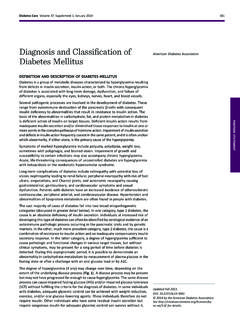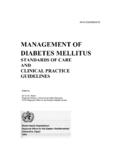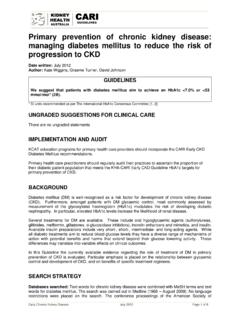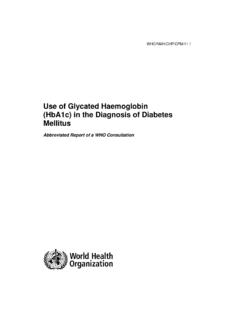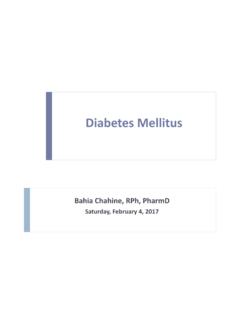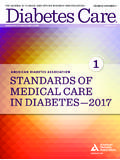Transcription of Detection of Diabetes Mellitus In Situ (Occult …
1 Complimentary Copy Provided to you By: Meridian Valley Laboratory 801 SW 16th St Suite 126 Renton WA 98057 Phone Fax Formatting has been modified for readability. Detection of Diabetes Mellitus In Situ ( occult Diabetes ) by Joseph R. Kraft, In recent years, further development and refinement of technique has permitted reproducible serum insulin determinations to become available for correlation, with plasma glucose levels during tolerance testing. In earlier presentations, 1,2 five basic insulin patterns were identified indicating the absence or presence of Diabetes through a wide range of insulin response (diabetic state). In a number of cases, normal glucose tolerances were associated with abnormal insulin patterns.
2 Such situations, in which the glucose tolerance curve was normal and correlated insulin pattern was abnormal, were considered indicative of pre- Diabetes or occult Diabetes . In order to focus greater attention upon this, the earliest detectable phase of Diabetes Mellitus , the term Diabetes Mellitus in situ has been proposed and used interchangeably with occult Diabetes throughout this report. It is the primary purpose of this paper to review basic insulin patterns which develop in the course of standard glucose tolerance testing and indicate the significance of each. Methods and Materials Blood glucose and insulin levels were obtained on 3650 patients randomly referred for glucose tolerance testing.
3 Specimens were collected after fasting and , 1, 2, and 3 hours after a 100 gram oral glucose meal or equivalent in children. Early in the study, the procedure was extended to include fourth-hour specimens. In many cases, the study included fifth-hour examinations upon referring physician request. Plasma glucose was determined via AutoAnalyzer (ferricyanide method) on the day collected. For the last 500 tolerances, AutoAnalyzer glucose measurement was made by the plasma glucose oxidase method. Specimens for insulin determination were frozen and assayed the following day utilizing the Phadebus Insulin radioimmumoassay test3 with a 1185 series Automatic Gamma Counting System (Searle Analytic).
4 In our laboratory, frozen insulin specimens provided reproducible results for at least six months. The Phadebus Insulin Test had duplicate procedure precision of 1 Standard Deviation = +5 microunits in measurements up to 150. Each glucose insulin tolerance assay was plotted graphically and correlated with specimen collection time. The Wilkerson Point System for plasma glucose values as recommended by the American Diabetes Association4 was used as a reference base for classifying and grouping results (Table 1). Complimentary Copy Provided to you By: Meridian Valley Laboratory 801 SW 16th St Suite 126 Renton WA 98057 Phone Fax Formatting has been modified for readability.
5 Age, Obesity and Sex Distribution Of 3650 glucose/insulin tolerances performed, there were 2345 females and 1305 males, ranging in age from 3 to 87 years (mean age of years). Two hundred-nineteen were 20 years or younger (mean age = ). There were 1825 in 21-49 age group, with a mean age of Of 1606 who were 50 years and older, the mean age was Subsequent studies concerning age and detectable phases of Diabetes Mellitus are pending. Obesity was considered present in male patients whose actual weight exceeded 115% of their adjusted ideal weight, and in female patients whose actual weight exceeded (146lbs).5 Twenty-nine percent of males and 40% of females were obese by these criteria (Table III).
6 Increased incidence of obesity was noted in females at the 3-point range on the Wilkerson scale. Review of the total number of cases failed to demonstrate a significant causal relationship between obesity and Diabetes Mellitus in this study. Family History of Diabetes Family history was considered positive when any diabetic relative was noted, regardless of kinship and without differentiation as to age, intensity, duration and/or therapy. When the first several hundred tolerances yielded only 35% positive family histories, less than anticipated, poor family history documentation was suspected. In order to avert this possibility, trained medical technologists were utilized as Diabetes history reporters during multiple patient contacts of the tolerance procedure.
7 This evolved as our routine, but such duplicate history inquiry failed to alter significantly the earlier, unassisted findings. There was a positive diabetic family history in 37% of the 3650 patients studied (Table III). Family history and normal glucose tolerance was judged insufficient to categorize normal in this study. Complimentary Copy Provided to you By: Meridian Valley Laboratory 801 SW 16th St Suite 126 Renton WA 98057 Phone Fax Formatting has been modified for readability. Results Pattern I Normal Before abnormal patterns could be identified, it was necessary, first, to define the normal fasting insulin range and normal insulin response to glucose.
8 When data on all 3650 cases in our series were analyzed, it became apparent that a small but significant number in each Wilkerson point grouping showed considerably higher fasting insulin values. Accordingly, cases with fasting values greater than 50 microunits (198 or 5%) were separated and will be examined as a group later constituting abnormal pattern IV. The remaining 3452 cases had a mean fasting value of microunits (Table IV) with a mean range of to which closely approximated the results of an earlier study examining the initial 2500 Applying +3 standard deviations of the procedure (3SD = + 15 microunits) to a mean of 15, the selected fasting insulin range was again between 0 and 30 microunits.
9 Figure 1A: Maximum insulin peak occurred at hour in 234 (40%) of the normals identifying Pattern I. Under normal circumstances, insulin peaks within the first hour (either at or 1 hour) following glucose loading and this typical pattern was found in cases displaying zero (0) Wilkerson point tolerances (Figs. 1 A and 1B). Thereafter, insulin levels declined sequentially at 2 and3 hours, returning to fasting range. Thus, the normal insulin pattern seen associated with a normal glucose tolerance test demonstrated the following basic features, which are also graphically displayed in figure 2A: Complimentary Copy Provided to you By: Meridian Valley Laboratory 801 SW 16th St Suite 126 Renton WA 98057 Phone Fax Formatting has been modified for readability.
10 1. Fasting level between 0 and 30 microunits 2. Peak insulin production at to 1 hour 3. Sequential return to fasting range at 2 to 3 hours 4. Stabilization on the fasting range beyond 3 hours Figure 1b: maximum insulin peak occurred at 1 hour in 334 cases (60%) of the normals identifying Pattern I. Figure 2A: Normal 568 cases with : a. fasting level between 0 and 30 microunits; b. peak insulin at or 1 hour; and c. return to fasting range at two to three hours. Since variance at second and third hours is also critical in diagnosis of Diabetes , 6,7 limits were developed and defined specifically to cover that segment of insulin response. Following normal insulin peak production at to 1 hour, the sum of second and third hour insulins should be 60 microunits or less ( , twice the maximum fasting range of 30) in order for the entire response (curve ) to be judged unequivocally normal.
